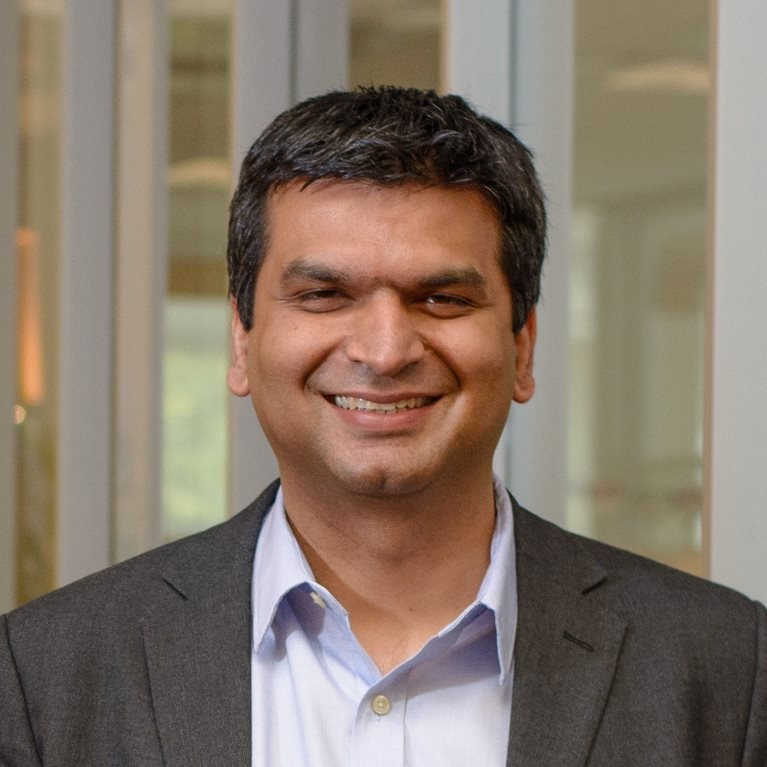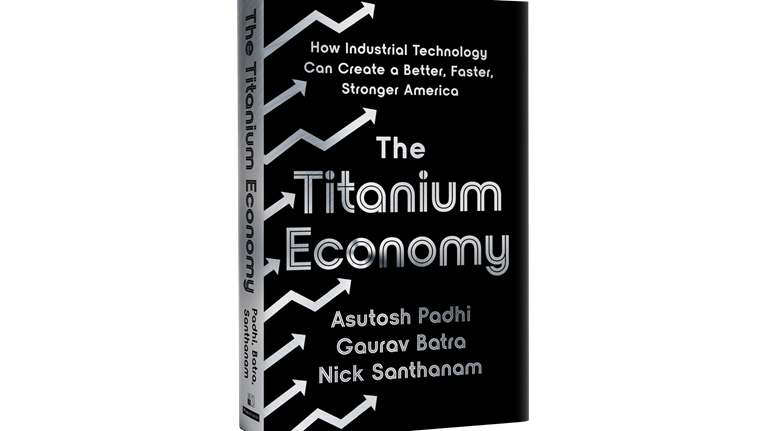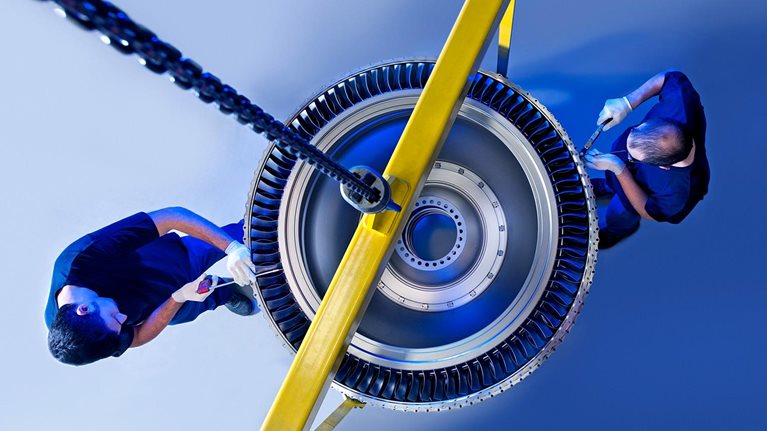In this edition of Author Talks, McKinsey Global Publishing’s Lucia Rahilly chats with McKinsey senior partner Asutosh Padhi and coauthors Gaurav Batra and Nick Santhanam about their forthcoming book, The Titanium Economy: How Industrial Technology Can Create a Better, Faster, Stronger America (Public Affairs, October 2022). You’ve probably never heard of the companies they cover — under-the-radar makers of a range of industrial products. But these companies make up a burgeoning sector that Padhi, Batra, and Santhanam say is just beginning its best years, and that has the potential to reinvigorate American manufacturing—sustainably and inclusively—in the process. An edited version of the conversation follows.
What problem were you hoping to solve with this book?
Asutosh Padhi: I believe titanium economy companies are not well understood and not well appreciated. I was hoping to shine a spotlight on what I think is truly an amazing set of companies that drive a lot of innovation and therefore job creation. Ultimately, these companies are going to be critical in creating a more inclusive economy in the United States.
Nick Santhanam: The problem we were trying to solve is lack of awareness. If you look at the industrial sector, it is truly a diamond in the rough. I would even go further and say it’s truly a diamond—maybe not even in the rough. When you talk to folks, you realize that there is a huge difference between what people believe about the industrial sector and what is reality. We wanted to fix that perception gap.
Gaurav Batra: When I was growing up, and even in the early years of my career, the industrial sector was not always viewed as a rosy picture, but my personal experience over the past two decades with the industrial sector is nowhere close to that perception. In reality, there is immense value being added to companies, to employees, and to communities—it’s really the heartbeat of an economy. My personal hope from this book is that we are able to bridge the gap between perception and reality and have folks see the value of the sector.
What surprised you in the research or writing?
Asutosh Padhi: Eighty percent of the titanium economy companies are private; therefore they tend to have a longer-term orientation. But the thing that surprised us was the high degrees of employee retention in these companies in the middle of the Great Resignation.
As we looked underneath, we could understand why: the compensation levels are different. They’re much higher in these companies. The amount of care and concern for the employees is different. People actually get access to different development opportunities, and I think there’s a culture and a purpose that comes from being part of that setup. It’s a combination of factors that brings it all together.
The importance of the talent proposition and how well the titanium economy companies intuitively understand that—not just today but for the past 50 to 100 years—was one of the things that really struck us.
The importance of the talent proposition and how well the titanium economy companies intuitively understand that—not just today but for the past 50 to 100 years—was one of the things that really struck us.

Nick Santhanam: Two things surprised me the most. I spent almost north of 30 years in the industrial sector, and I knew it was a great sector, but I did not realize how many companies out there were doing so well in the stock market. When Gaurav showed me the list, I fell out of my chair.
I said, “This can’t be true. You can’t have this many companies who are doing better than S&P 500, who are doing better than Nasdaq-100. Wow.”
The second thing, which in a lot of ways provoked us to write the book, is that this is not an industry that is dead. We knew it was a good sector, but we went in thinking “this was a sector that was stolen. This was a sector that was given away. This was a sector that was taken away from us.”
We realized all of that was false—this sector was not stolen, it was not taken away, and it was not given away. It’s a great, vibrant sector that creates a lot of jobs and a lot of livelihoods. As we talk about it in the book, the best of days are yet to come.

I thought we were going to be telling a story of the past or, at least, saying, “Hey, these are our best days.” As we finished the book, we walked away saying, “Boy, we are in the first innings.”
Gaurav Batra: We discussed the book with about 50 to 70 CEOs in the ecosystem, and they all agreed with the messages. The surprising thing for me was, if you agreed with them, then why didn’t you act on them? We also talked about how so many of the titanium economy companies are private, so they’re not really worried about quarter-over-quarter or how investors are looking at them.
I would say that was the biggest surprise for me, how the alignment with the key messages of the book—the potential of titanium economy—was pretty widespread.
What in your own background inspired you to undertake this research?

Asutosh Padhi: I’m a mechanical engineer by background, but I never practiced mechanical engineering. I went to business school and then joined McKinsey directly out of campus, but deep inside me there’s always been a mechanical engineer. The thing that’s always fascinated me is the importance of innovation and how much of it resides in places that we would not associate with innovation.
I saw that in the course of my work at McKinsey. I saw a set of companies that everyone talks about, that is known for innovation, and that is great at innovation: I saw software, I saw technology. The thing that surprised me was that there is an equally great set of companies that are great at innovation, that are manufacturing oriented, yet no one associated innovation with this set of companies.
Gaurav Batra: A couple of personal experiences were transformational in terms of my own thinking about the sector. I’m a mechanical engineer by training, and one of my first jobs was as a manufacturing manager for a detergent powder factory back in India.
The India factory was in a tribal area—the government used to give tax incentives—so my workforce was made up of about 200 people who probably couldn’t even write. They were coming to the factory daily, producing tons of detergent powder, which was getting distributed all through the country.
That was the first time I really saw the human value of what a healthy manufacturing organization can do: 200 people were relying on it for their daily needs. It was a vehicle for social mobility for them. They came from really underprivileged backgrounds and being able to earn a healthy salary gave them a chance to take their families to the next level, put their kids through education, give them proper training, and have better lives themselves.
That was one of the first personal experiences that transformed my thinking about the industrial sector and what it could do for not just for the companies but also for a broad swath of people who were involved with that ecosystem.
Nick Santhanam: I’m a chemical engineer. I came to this country in 1991, and my very first job was for a company called Johnson Matthey, where I did a lot of work on the manufacturing line. Then, I worked for a company called Arlon, which was a printed circuit board company, and then a company called Taconic, which was also in that space.
This was the time of Y2K, when everybody was a computer programmer. I believed that I added more value because products were needed. These were real products being shipped, affecting people’s real livelihoods, and yet people did not know what Johnson Matthey did, or Arlon, or Taconic.
That, in a lot of ways, provoked me to say, “This is a great story. It’s a great truth, and I think it’s worthwhile for people to know. Then people can make their own decisions, but let’s get the facts out there.”
Tell us about the companies you profile in The Titanium Economy.
Nick Santhanam: We talked to about 35 companies, which we have profiled in the book, as well as an additional 50 companies. I believe every one of them is an unsung hero on their own merits, on the value they have created—for the ecosystem and for their customers. As much as I wish I could say it’s company A versus company B, all of the 35 companies we profiled in the book and the 50-odd companies we talked to are unbelievably great companies.
Asutosh Padhi: You walk into one of these companies, and the places look clean; the machines are new; the people are working together in teams; the place is inviting. You get the sense that there is something happening that is much more modern and oriented around precision manufacturing, whether it’s using new materials, new technologies, or different types of equipment.
You also get a sense of purpose: Why are these people so excited to be here? It is because they believe that they’re driving innovation, that they’re doing things that are important to our future.
What will it take to get the titanium economy to where it needs to be to enable a more inclusive economy?
Asutosh Padhi: My dream is that the titanium economy in the United States not only continues to flourish but continues to accelerate. Making that happen will require individual companies to step up further. In my conversation with CEOs we’re always asking the question, “How high is high? How much more innovation could you do? Which other customers could you be serving? What does that imply about new products you can launch?”
The other part of it is the enabling factor: it’s the role that the government and policy can take to enable investing in infrastructure, investing in people, and finding a way to drive a closer connection between corporate America—especially the titanium economy companies—and the places where talent is available, like vocational colleges and community colleges. Anything that we can enable will help grow the titanium economy.
My hope is that the titanium economy continues to scale, and that as it scales, it will continue to drive job creation, innovation, and exports. It’ll drive an amplification effect, where it will create jobs in adjacent industries, and it will help local communities thrive. It’s also my hope that the titanium economy becomes more diverse.
My hope is that the titanium economy continues to scale, and that as it scales, it will continue to drive job creation, innovation, and exports. It’ll drive an amplification effect, where it will create jobs in adjacent industries, and it will help local communities thrive.
More importantly, I hope that the debate shifts. Today the debate around manufacturing in the US is one that is very pessimistic. It always has a tinge of “this is yesterday.” I’m hoping the debate now shifts to optimism and possibilities, and the fact that this is our future, not yesterday.
Gaurav Batra: I’ve served the sector in my capacity as a partner at McKinsey over the past 12 years. In every instance, you could draw a direct correlation between how well a company does and what kinds of opportunities it starts affording its own employees.
I have personal examples where I have supported my clients as they turn into better operational companies, and folks from the front line have done well; they’ve changed the way they work; they’ve risen in the company and become managers, directors, and VPs.
I think that’s a great example of the potential that the titanium economy company might offer, not just for the executives but for the employees who are working there, in terms of their own social mobility and social stature.
What do you think the hardest part of achieving that aspiration will be?
Asutosh Padhi: The toughest part of realizing that aspiration will be addressing the lack of awareness around who these titanium economy companies are. These companies are all around us every day, yet we don’t actually know them. They don’t make the covers of the most important magazines we read, or the newspapers we read, or the news channels we watch.
As a result, over a period of time, they could easily have a talent deficit—people may not want to work there. Part of the reason we wrote this book is to highlight the importance, the purpose, and the role that these companies play in our country and therefore find a way to ensure that there’s a flow of talent, a flow of innovation, and a continued focus on enabling these companies to be successful.
Gaurav Batra: I think it’ll be a true team effort. The key members of the team would be the executives in the industrial ecosystem today who are running small, mid-cap, and large-cap companies—from the frontline managers up to the CEOs. They have to realize and understand the urgency of achieving their company’s true potential. They have to understand what their true potential is and create a path to it.
Second, investors need to start thinking about industrial as a good place to start investing, not just from an altruistic perspective but also from a financial perspective. If you look at examples in the book—HEICO is a great one, Trex is a great one—they’re real diamonds in the rough that perform better than any index you can come up with over decades.
Finally, the third members of the team would be public-policy experts, particularly focused on the talent gap coming up between supply and demand. That’s where we need some public-policy-level decisions, which will help close that gap in the coming few years. These three types of folks have to put in a team effort over the next few years to make this happen.
Who did you write this book for?
Asutosh Padhi: We have written the book from the standpoint of a student who is graduating today, and who’s considering different choices. We’re saying, “Where do you want to spend the rest of your career? Do you want to go and work in the services industry, which you absolutely can do? Or do you instead choose to do something different? You may come back after reading the book and say, ‘I actually want to work in manufacturing.’”
The old image of manufacturing—which was around factories that were greasy and dirty—doesn’t exist anymore. Will this start to attract a more diverse set of people to come work with these companies?
Nick Santhanam: My daughter is 24. Folks who have a 24-year-old daughter realize that dads are usually not the person who does anything right. Once I walked into her room and she was hiding something, and I said, “What are you hiding?” She said, “Nothing.” Then I realized that she was reading the book, and she was halfway through. She sort of sheepishly said, “You know, this book is not that bad.” For people who know the father–daughter lingo, that means it’s actually pretty good.
This is when it resonated with me that this is a book for pretty much any audience, because it brings what the industrial sector is to life. It’s not about pontificating; it is not about victimizing or blaming somebody. It’s about what the sector is, what the sector has done, and what the sector could be—based on facts, in the classical McKinsey fashion.
We’ve used data to lay out the story, and people can make their own decisions. We are not telling people, “This is the answer.” We don’t want to tell the answer. We have laid out the facts. Whether you’re an investor, whether you’re a 24-year-old employee joining the workforce, or you’re the CEO of an industrial company, we believe this is a good book for them, for all of them.
Why haven’t industrial companies invested more in storytelling about their successes?
Asutosh Padhi: The titanium economy companies are under the radar because they are, in some sense, everywhere, so you can’t find them at a single place. They are private, so you don’t find them listed on the stock market. They don’t have business-to-consumer brands, so they don’t have the need to advertise.
Because they tend to be smaller from the standpoint of revenues, they don’t make headlines in the news media. Titanium economy companies have been going about doing what they’re actually good at, which is delivering great returns for their shareholders, taking care of customers, taking care of employees, doing the job around communities, and cleaning the environment—but they have never really found an opportunity to pull it all together and tell the story.
Gaurav Batra: Industrial companies haven’t invested more in storytelling for the same reason we are excited about this sector: because it’s not on a technology treadmill. You don’t see an industrial company coming up and then disappearing in three or six years. On the flip side, this also brings a sense of complacency. You may think, “I’m making 10 percent margin, 15 percent margin, that’s not bad. It’s not great, but it’s not bad either.” There’s limited reason to complain.
The urgency to change, the need to change, the burning platform don’t necessarily exist. This is where I think we get to the crux of the problem: the narrative, the mindset about the sector overall, has to change. It should be less about “are we comfortable?,” because we are comfortable; I think it’s a very healthy sector today in the US, but it can be a lot healthier. So, we find the true potential of the sector for the country and frame all our discussions through that lens.
I think it’s a very healthy sector today in the US, but it can be a lot healthier. So, we find the true potential of the sector for the country and frame all our discussions through that lens.
Nick Santhanam: The industrial sector works hard for their money. Every time they’ve gotten an improvement, it’s because they have driven a true performance improvement, versus just getting valued more, which is, as we call it, the multiples. The analogy is, if you’re buying a house, you buy it for a dollar per square foot. Three years later, you’d pay more for the same house because you’d pay more dollars per square feet.
Industrial is a sector where you continue to pay the same, so you only get more if you build more houses or make more earnings. I think that’s because the sector has not been good at storytelling. It hasn’t gotten its message around about how great it is, and I think fixing that is going to solve a trillion-dollar question, which is creating their trillions of dollars in valuation.
What has been the experience of industrial companies during this period of profound disruption, including COVID and the energy transition?
Asutosh Padhi: One of the things that struck me is that we’ve been having a lot of discussion about the energy transition, and I think there’s widespread concern about the fact that companies are doing a lot of greenwashing. I was skeptical too, but then I started to look at what these companies are doing. They’re inventing technologies that will actually help with carbon capture and sequestration.
Take a company like Trex: they’re recycling plastics to make outdoor wooden decks that are 97 percent recycled. There are waste management companies we talk about in the book that are using advanced analytics. Normally when you throw out the garbage in your house, if you’re like me, you are not particularly good at figuring out what is garbage and what should be recycled.
Companies are now using artificial intelligence to sort through trash and figure out how to optimize waste management. They’re not talking much about it, but they’re making it happen.
Nick Santhanam: The industrial sector is extremely resilient. It’s probably one of the very few sectors that follows “live and let live.” Unlike other sectors—retail or tech, for example—where companies have a meteoric rise and a meteoric fall, you don’t have that here, which is a greatness of the industrial sector: it’s very resilient.
Industrial companies make great products. They make great margin. They’ve been wanted. Yes, they’ve gone through rough spots, but even through the rough spots, they end up coming out all right. They’re very resilient.
Unlike other sectors—retail or tech, for example—where companies have a meteoric rise and a meteoric fall, you don’t have that here, which is a greatness of the industrial sector: it’s very resilient.
What are the top lessons that you would like readers to take away from reading this book?
Asutosh Padhi: The most important lessons are around the importance of recognizing innovation and technology. We have a very strong foundation in the United States to build from; we have a set of about 5,000 companies that have been driving the titanium economy’s growth, not just for the past five to ten years, but for the past 100 years.
I think we are still early on that journey to the full potential of the titanium economy. Over time it could perhaps be two or three times the scale of what it is today. It could help us create a lot more jobs, and it could have the amplification effect we talked about. When it scales, it will help us create a much cleaner planet. It will help us create a most inclusive economy, and my personal hope is that it also becomes more diverse.


